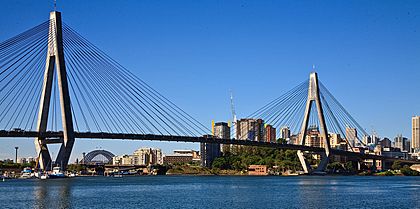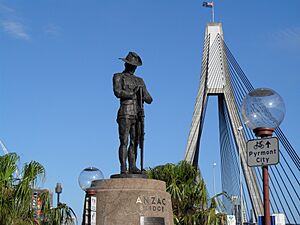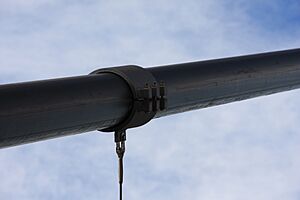Anzac Bridge facts for kids
Quick facts for kids Anzac Bridge |
|
|---|---|

Anzac Bridge with the Sydney Harbour Bridge in the background, viewed from Glebe Point
|
|
| Coordinates | 33°52′10″S 151°11′09″E / 33.869340°S 151.185780°E |
| Carries | Western Distributor |
| Crosses | Johnstons Bay |
| Locale | Sydney, New South Wales, Australia |
| Other name(s) | New Glebe Island Bridge |
| Named for | Australian and New Zealand Army Corps |
| Owner | Roads and Maritime Services |
| Characteristics | |
| Design | Cable Stayed |
| Material | Concrete and steel |
| Pier construction | Reinforced concrete |
| Total length | 805 metres (2,641 ft) |
| Width | 32.2 metres (106 ft) |
| Longest span | 345 metres (1,132 ft) |
| Piers in water | 2 |
| History | |
| Contracted lead designer | NSW Roads & Traffic Authority |
| Constructed by | Baulderstone |
| Construction cost | A$170 million |
| Opened | 3 December 1995 |
| Replaces | Glebe Island Bridge |
The Anzac Bridge is a large cable-stayed bridge in Sydney, New South Wales, Australia. It has eight lanes for traffic and carries the Western Distributor (A4) road. The bridge crosses Johnstons Bay, connecting the areas of Pyrmont and Glebe Island (which is part of Rozelle).
This bridge is very important for Sydney. It helps connect the city's main business area, the Sydney Harbour Bridge, and the Cross City Tunnel to the Inner West and Northern Suburbs. It's a key part of the city's road system.
Contents
History of the Anzac Bridge
Earlier Bridges at Johnstons Bay
Before the Anzac Bridge was built, there were two other bridges that crossed Johnstons Bay.
The first bridge was built in 1862. It was a long timber bridge, about 318 meters (1,045 feet) long and 8.5 meters (28 feet) wide. It also had a special section that could swing open to let ships pass through. This bridge replaced an old steam ferry service.
The second bridge, called the Glebe Island Bridge, opened in 1903. It was an electrically operated swing bridge, similar to the Pyrmont Bridge in Sydney. This bridge was designed by Percy Allan. As Sydney grew, traffic became a big problem. The swing bridge had to close often to let ships into Blackwattle Bay, causing long delays for cars. This led to the decision to build the Anzac Bridge. The 1903 Glebe Island Bridge is still there, but it's no longer used by cars or people.
Building and Naming the Anzac Bridge
The design for the new bridge was created by a team from the NSW Roads & Traffic Authority. The main engineer for the bridge's design was Ray Wedgwood. The company that built the bridge was Baulderstone.
The bridge first opened to traffic on December 3, 1995. At that time, it was still called the Glebe Island Bridge.
Three years later, on Remembrance Day in 1998, the bridge was given its current name: the Anzac Bridge. This was done to honor the brave soldiers of the Australian and New Zealand Army Corps (known as Anzacs) who fought in World War I.
To remember these soldiers, an Australian Flag flies on top of the eastern tower, and a New Zealand Flag flies on the western tower.
On Anzac Day in 2000, a bronze statue of an Australian Anzac soldier was placed at the western end of the bridge. This soldier, often called a "digger," is shown holding a rifle. In 2008, a statue of a New Zealand soldier was added across the road from the Australian one.
About the Anzac Bridge
The Anzac Bridge is 32.2 meters (105 feet) wide. Its main section, which is held up by cables, is 345 meters (1,132 feet) long. The two tall towers that support the bridge are 69 meters (226 feet) high. These towers hold up the bridge deck using many strong cables.
When the bridge was first built, the cables sometimes vibrated. Engineers fixed this by adding thinner, smaller cables between the main ones to make them more stable.
The bridge isn't just for cars! On its northern side, there's a special path for pedestrians and cyclists. This path is separate from the car lanes, making it safe for people to walk or ride bikes across the bridge. You can even walk from Glebe Point Road, over the bridge, and around Blackwattle Bay back to Glebe Point Road.
The Anzac Bridge was designed to carry a lot of traffic. It can handle up to 180,000 cars every day. Just seven years after it opened in 1995, it was already reaching its maximum capacity in 2002.
For safety, the bridge is regularly watched by security guards and cameras. The speed limit on the bridge is 60 kilometers per hour (about 37 miles per hour). It used to be 70 km/h, but it was lowered in 2005. Also, before 2005, the bridge had seven traffic lanes, but now it has eight.
There used to be bus stops at the western end of the bridge. However, they were removed because buses pulling out from the stops caused problems with other cars moving at high speeds. The Australian Anzac statue is near where the old city-bound bus stop was.
Anzac Bridge in Movies and Music
The Anzac Bridge has appeared in several movies and songs:
- In the 1999 movie Looking for Alibrandi, the main character, Josephine Alibrandi, and her friend Jacob Coote ride across the bridge on a motorcycle.
- Deni Hines' music video for her 1995 song "It's Alright" shows the bridge when it was almost finished, just a few months before it opened.
- The band You Am I mentions the bridge in their 1995 song "Purple Sneakers". The song starts with the line "Had a scratch only you could itch, underneath the Glebe Point bridge". This song was written before the bridge was renamed the Anzac Bridge.
Gallery
Images for kids












